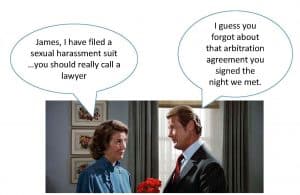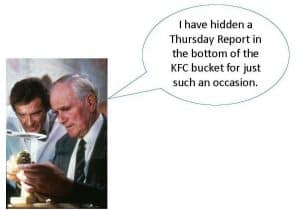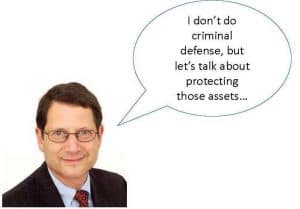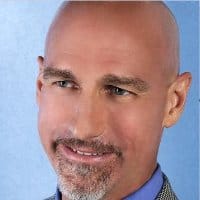The Thursday Report 5.25.17 – The Man with the Golden Thursday Report

The Asset Protection Continuum (pt. 3 of 3) by Martin Shenkman and Alan Gassman
6 Essential Ingredients to Life Insurance ADVICE by Barry Flagg
Phantom of the Income – Is the Trustee of a Trust That Requires All Income to be Paid to a Beneficiary Required to Pay out Amounts of Phantom Income to the Beneficiary? by Christopher Denicolo
Can an IRA and IRA Owner Invest in the Same Business? by Brandon Ketron
The Toughest Choice You’ll Ever Make as a Business Owner (and you’re probably unaware it’s even a choice you’ve made!) by David Finkel
Richard Connolly’s World – SLATs Provide Flexible Plans for Many Clients
Thoughtful Corner
Humor! (Or Lack Thereof!)
We welcome contributions for future Thursday Report topics. If you are interested in making a contribution as a guest writer, please email Alan at agassman@gassmanpa.com
This report and other Thursday Reports can be found on our website at www.gassmanlaw.com
Quote of the Week

A.…… Can you name them all?
B.

C.

D.

E.

“You see, by pulling out this button sir, it turns the watch into a hyper-intensified magnetic field. Powerful enough to even deflect the path of a bullet at long range..or so Q claims..”
-James Bond
F.
In the present times when state secrets are being revealed at the drop of the hat, we at The Thursday Report felt it was finally time to come clean with our audience……. We are agents for MI6, codenamed 00Thursday. While we may not get into as many dangerous situations as James, we are always overcoming the odds to bring you the best in law and humor (ahem). We decided it was time to let you into the world of the 00’s and brought some old nemeses along for the ride. This Thursday Report will self- destruct in 10 seconds.
When Ian Fleming wrote the first James Bond book in 1953, he could not have foreseen the incredible societal and entertainment phenomenon that the series would ignite. The first book, Casino Royale, was a blockbuster hit, followed by the second book, Live and Let Die, in 1954, and the third book, Moonraker, in 1955.
The first James Bond movie, “Dr. No”, was released in 1962, and was an overnight success, featuring Sean Connery as James Bond.
There have also been spoofs of James Bond, including Charles Feldman’s “Casino Royale” featuring Woody Allen as James’s nephew, Jimmy Bond, Mike Myers in the Austin Powers trilogy, and the television show Get Smart, which featured an American counterpart, Agent 86, who was romantically involved with Agent 89.
Ian Fleming would not have foreseen today’s situation with respect to questions concerning spies, lies, and Kentucky Fried Chicken and Fries.
- Roger Moore: 1972-1985
- Sean Connery: 1962-1967, 1971
- Colonel Harland Sanders: We can dream, can’t we?
- Timothy Dalton: 1986-1994
- Pierce Brosnan: 1994-2004
- Daniel Craig: 2005-Present


The Asset Protection Continuum Practical Steps for Estate Planning Lawyers and Other Professionals (pt. 3 of 3)
by Martin Shenkman and Alan Gassman
Business and Entity Protection
A number of common, but not used with sufficient frequency, business arrangements may help to provide protection from having potential future creditor claims decimate a business or professional practice. The following discussion covers only some of these planning opportunities. Quite often there is one business entity, which may be an LLC or regular corporation, which conducts the business, owns furniture, equipment, inventory and accounts receivable, and files taxes as a separate entity, which may be as an S corporation, a partnership, or disregarded for income tax purposes.
The tax treatment of the business entity can play an important role in what can be done from a coordination standpoint. Many advisors are not aware that an LLC may elect to be treated as a regular “C” corporation, an S corporation, or a partnership for federal income tax purposes. The risk of losing the assets of the company to a future creditor can be significantly reduced by using some of the following strategies. However, before implementing further strategies, first assure that the business is being operated with all appropriate formalities. Consider: obtain a certificate of good standing to confirm the status of the business; obtain and review all governing documents to assure that they are adequate, reflect current ownership interests, and are being adhered to; confirm that there is a CPA preparing adequate books and records, monitoring distributions, testing or reviewing compensation and perquisites to be certain that they are reasonable; and so forth. Once the basics are addressed, explore additional step:
- Move assets out into a separate leasing or licensing entity that can have an arm’s-length relationship with the operating entity, if this will not trigger material taxes. It may be possible for a business entity taxed as an S corporation or a C corporation to avoid taxes being incurred upon separation by entering into what is known as a new Parent F reorganization, whereby a new company will own the existing operating company and a new “brother/sister company” that can receive valuable assets from the operating company without triggering income taxes.
- Have the company owe shareholders pursuant to loans, or indebtedness to others. A legitimate creditor can be given a lien against entity assets in the same way that a bank normally takes a mortgage lien against a house. Liens given against physical assets and also intangible assets like accounts receivable are normally “perfected” by the filing of UCC-1 Financing Statements in the state where the assets are maintained. Consider factoring accounts receivable to an entity owned for the primary benefit of family members in the next generation, to help with estate tax planning, and also pare down the balance sheet.
Domestic Asset Protection Trusts (“DAPTs”) and Foreign Asset Protection Trusts (“FAPTs”)
When most practitioners think of asset protection planning the first thoughts often turn to domestic asset protection trusts (“DAPTs”) or foreign asset protection trusts (“FAPTs”). While a high percentage of the literature on asset protection for estate and business planning lawyers and advisors concentrate on asset protection trusts, there are a good number of planning techniques and arrangements which provide excellent creditor protection planning without the need for the complexity and expenses associated with an asset protection trust, whether a DAPT or FAPT.
Risks and Challenges of DAPTs
In the German[1] case the question at issue was whether the decedent held interests in the trust that caused estate tax inclusion. In 1969 the decedent transferred property to an irrevocable trust. The trust permitted the trustees, in their absolute discretion, to pay any or all of the income or principal of the trust to the decedent at any time during her lifetime. The precondition to any such distribution was that the trustee had to first obtain the written consent of the beneficiary who was entitled to receive the principal and accumulated income of the trust after the decedent’s death, i.e. the remainder beneficiary.
If the decedent, as a result of this arrangement, was to be considered from an estate tax perspective as if she continued to enjoy the right to the income or principal of the trust until death, the trust assets would be included in her estate. This turned on the application of Maryland law. Specifically, the issue was whether under Maryland law, if the decedent incurred any debts during her lifetime, could her creditors still attach trust assets to collect those debts. The court found that Maryland law did not give decedent’s creditors the right to reach trust assets, and, accordingly, her gifts were completed at the time she transferred the assets in trust, and they were no longer subject to estate tax on her death.
In 2009 the Internal Revenue Service (“Service”) issued a private letter ruling which concluded that a trustee’s discretionary right to pay income and principal to the grantor, the grantor’s spouse and descendants, did not cause the trust assets to be included in the grantor’s estate.[2] But the Service warned that if there was a pre-existing arrangement or understanding between the grantor and trustee that the assets would be included in the grantor’s estate. This points to the importance of operating the trust properly and carefully. This suggests that the operation of the trust would be critical to the determination of estate exclusion.
In 2011 an Alaska court, in Mortensen, held that transfers to an Alaska DAPT were included in the grantor’s bankruptcy estate, and hence, reachable by his creditors.[3] This was a classic “bad facts” case. The grantor was in dire financial straits when he established the trust, had credit card debt, and was struggling with post-divorce financial issues, when he transferred substantially all of his property to the trust. The facts were as opposite as they could be from those of a wealthy taxpayer planning to fund millions of dollars to a completed gift DAPT in 2012 for estate planning purposes. Mortensen was clearly not an appropriate candidate for a DAPT, the planning was poorly designed and executed, but most significantly, he filed for bankruptcy less than ten years after funding the trust. Under the bankruptcy law, during the 10-year period following transfers to a self-settled trust, the bankruptcy trustee can avoid the transfer. So, the lessons of Mortensen are to be certain that your client is an appropriate candidate for a DAPT, execute the planning with prudence, and if your client runs into trouble don’t file bankruptcy if it can be avoided for the 10-year window. In spite of the bad facts this case created negative perceptions of DAPT.
A specific concern Mortensen creates for DAPTs is that, according to some commentators, a transfer to a DAPT is a per se fraudulent transfer, if such a transfer were a per se violation of the fraudulent transfer rules, then creditors could reach the assets in the trust, so that the trust assets would be included in the taxpayer’s estate. Not all commentators agree. Others believe a transfer must be consummated with an actual intent to defraud, and that the “per se” concept is too harsh an interpretation. The “per se” theory, they argue, if extended to its natural limits, could conceivably characterize every gift any taxpayer makes which is susceptible to being transferred as a fraudulent transfer, and thus, an incomplete gift. This is an unreasonable conclusion and one that could enable taxpayers to argue that any gift the Service seeks to tax are incomplete transfers. Just because a transfer could be deemed to be fraudulent and therefore available to creditors, would suggest no transfer is complete until the statute of limitations on a challenge has tolled. That is not a reasonable interpretation and certainly has not been followed by the Service.
An Illinois case also ruled unfavorably on the use of a self-settled trust.[4] The following simplified time line of the facts in the Rush U case and Robert W. Sessions (“Sessions”) activities, will be helpful to understanding the case.
- February 1, 1994 – foreign asset protection trust established and funded with family limited partnership (“FLP”) interests.
- Fall 1995 – Sessions made a pledge to a local charity.
- April 19, 2005 – Sessions created a revocable trust and contributed his 1% general partnership interest to the trust.
- April 25, 2005 Sessions died.
On February 1, 1994 Sessions, as grantor, established the Sessions Family Trust in the Cook Islands as a foreign asset protection trust (“FAPT”). The FAPT was irrevocable and included a “spendthrift” provision. The FAPT distribution standards permitted the trustees to make distributions to Sessions of income or principal of the trust for his “maintenance, support, education, comfort and well-being, pleasure, desire and happiness.” Sessions himself was named Trust Protector of the FAPT. In this capacity, he retained the power to remove trustees, to veto any discretionary actions of the trustees and the power to appoint or change beneficiaries in his will. Sessions transferred 99% of his FLP and property located in Hinsdale, Illinois, aggregating $19 million, to the FAPT.
In the fall of 1995 Sessions made a pledge to a local charity, Rush University Medical Center (“Rush U”), of $1.5 million. The pledge was for the construction of a new president’s house on the university’s campus in Chicago. In reliance on his pledge the charity built the house and held a public dedication honoring Sessions. Sessions executed several codicils to his will reflecting that any portion of the pledge that was unpaid at his death should be paid from his estate.
On September 30, 1996 Sessions sent Rush U another letter confirming the charitable pledge he had made. Thereafter, Sessions was diagnosed with cancer and blamed Rush U for its failure to discover the cancer early on. Sessions died on April 25, 2005. On December 15, 2005 Rush U filed an amended complaint against Sessions’ estate to enforce the pledge. The third count in the complaint relied on the principle that if the settlor creates a trust for his own benefit it is void as to existing and future creditors and that those creditors can reach his interest in the trust. This common law rule was supported by a number of Illinois cases.[5]
The court stated the common law rule as follows, noting that it did not require that the transfer be a fraudulent conveyance: “Traditional law is that if a settlor creates a trust for the settlor’s own benefit and inserts a spendthrift clause, the clause is void as to the then-existing and future creditors, and creditors can reach the settlor’s interest under the trust.” The trustees of the FAPT argued that the common law principle stated above was supplanted by the Fraudulent Transfer Act (“Act”) and that the Act provided specific mechanisms to prove that a transfer was fraudulent. The complaint filed by the charity, however, did not allege “that the decedent made a transfer to the trusts ‘with actual intent to hinder, delay, or defraud’.” The trustees advocated that the Act superseded common law rights that might have made a transfer to a self-settled trust considered to be a fraudulent transfer per se, and hence void. If the Act did supersede the common law, then the charity Rush U, would have to prove that the funding of the trusts was a fraudulent conveyance under the Act. The appellate court reversed the lower court and held that the common law cause of action was abrogated by the UFTA.[6] The appellate court found that if the legislature intended self-settled trusts to remain per se fraudulent under the common law, it would not have promulgated a statue defining the conditions required to prove a transfer was fraudulent.
There is no clarity in the facts presented in the case whether Sessions had inadequate assets when he made the charitable pledge. The facts seem to indicate that Sessions may have had appropriate intent to benefit the charity, and only after his cancer was misdiagnosed by Rush U did he opt to endeavor to avoid the pledge. Unfortunately, as noted above, the Illinois Supreme Court had no alternatives to finding Sessions liable because the charity’s complaint did not allege a fraudulent conveyance under the Act. So absent finding a common law remedy as the Supreme Court held, the FAPT would have been relieved of any liability.
The Illinois Supreme Court held that common law creditor rights and remedies remained in full force, even after enactment of the UFTA in Illinois, unless expressly repealed by the legislature, or modified by court decision. The reasoning of the Supreme Court can be summarized in its quote from a case from 1898 “…it would make it possible for a person free from debt to place his property beyond the reach of creditors, and secure to himself a comfortable support during life, without regard to his subsequent business ventures, contracts or losses.” There is certainly no assurance that a court in another state would take a similar view of the law.
Many state courts have held that self-settled trusts are accessible to creditors. There is precedent in New York and New Jersey that a self-settled trust is void as against public policy. But there are no cases analyzing the application of this with respect to a self-settled trust state, like Alaska, Delaware, South Dakota or Nevada. If your client lives in one of the states permitting self-settled trusts, then your client can likely use a DAPT. If your client, however, does not reside in one of those states, then there may be an issue, but how much of an issue remains unclear for several reasons.
Courts have remained critical of DAPTs, because judges are generally unfamiliar with how these trusts work, and often have an unfavorable attitude when the law of a jurisdiction outside of the judge’s reach and command are used to protect assets that may have significant relationships with the jurisdiction where the judge is located. For example, in the 2013 Bankruptcy Court decision of Huber, a bankruptcy judge in Washington State held that Washington State law, in lieu of the protective Alaska law, applied where the debtor had established an Alaska LLC and placed Washington State real estate into the LLC, and then transferred the ownership of the LLC to an Alaska Creditor Protection Trust.
A key issue for DAPTs is whether protection provided by these trusts will be afforded to settlors not residing in those states? What protection, if any, is available for someone residing in a non-DAPT state that creates a DAPT in a state permitting such trusts?
The Restatement of Conflicts of Law Section 273 concerning restraints on alienation of trust interests creates a further issue for DAPTs. This provides that the local law of the state in which the settlor has manifested an intention for the trust to be governed should control. But Section 270 of the Restatement provides that an inter-vivos trust is valid under the local law of the state designated, provided that application of its law does not violate a strong public policy of a state which has the most significant interest in the trust. This could imply that the non-DAPT state may successfully maintain that a DAPT created by its resident to escape creditors in its jurisdiction violates a strong public policy of that state. This interpretation could obviate the benefits of a DAPT for a resident of a non-DAPT jurisdiction. The Uniform Voidable Transactions Act raises further concerns. Section 4 comment 2. Might make a DAPT voidable per se for a non-DAPT resident. Example: A resident of New Jersey (which does not permit self-settled trusts) creates a DAPT in Alaska (the first state to permit self-settled trusts), New Jersey courts may permit creditors to reach that trust as being void per se.
The issues set forth above for DAPTs cause many planners to conclude that offshore jurisdictions should be used in lieu of domestic ones, but the costs and tax compliance burdens associated therewith are commonly much more than applies for DAPTs. Many DAPTs are structured to provide that there will be an automatic transfer of the trust to an offshore jurisdiction in the event of any challenging circumstances, and the laws of many offshore jurisdictions provide that the statute of limitations that applies there for a trust moved from another jurisdiction begins when the trust was originally formed. Nevis now has statutes that require a creditor challenging a Nevis trust or Nevis LLC to deposit $100,000 per challenged entity into the court registry, and provides that tenancy by the entireties assets conveyed to a Nevis Trust retain their character as tenancy by the entireties.
In addition, the DAPT may be structured to not include the Grantor as a beneficiary unless unforeseen circumstances occur, such as if the Grantor’s net worth, which may include consideration of creditor exempt assets and assets owned by and with a spouse so long as the parties are married. Some planners prefer to have an independent party given a power to add beneficiaries to the trust, which may include the Grantor.
Conclusion
Although asset protection trusts are a valuable asset protection technique, it is important for clients and practitioners to know that there are other less expensive and less complex mechanisms that can be put into place to provide valuable creditor protection. In many situations a combination of such methods, which may also include the use of an asset protection trusts may also be considered. The asset protection continuum introduced in this article will hopefully help practitioners guide all clients through a range of asset protection planning that will help each client achieve a level of protection that is appropriate for that client’s circumstances and budget.





 6 Essential Ingredients to Life Insurance ADVICE
6 Essential Ingredients to Life Insurance ADVICE
by Barry Flagg
Reprinted from the Steve Leimberg Estate Planning Email Newsletter – Archive Message #2547, dated May 17, 2017
Life insurance is among the last asset types to be brought under the wealth management process. For this reason, it is often the most-neglected asset in the planning of the estate and financial planner and on clients’ balances sheets. As with most other things, neglect breeds poor performance. It, therefore, comes as no surprise that life insurance has been among the worst-performing asset types relative to clients’ expectations for decades.
This is not to say that life insurance has performed poorly relative to performance benchmarks for the asset-classes of invested assets underlying policy cash values. To the contrary, the performance of invested assets underlying policy cash values are quite consistent with the performance of other like-asset-class investments found outside life insurance. As such, disappointment has more to do with overly-optimistic expectations than actual under-performance.
This is because the life insurance industry’s operating principles were never designed to deliver on expected performance. Instead, the industry’s operating system (O/S) was designed to build and sell new products, as evidenced by the primary “output option” being illustrations of hypothetical policy values, and prevailing sales practices to compare such sales proposals for a new product to illustrations for an inforce policy as supposed due diligence and decision support.
As we will see, such illustration comparisons too often involve presenting new products using overly-optimistic assumptions in comparison to an inforce illustration too often reflecting less than realistic assumptions. For instance, in the 1980s, universal life (UL) products were generally illustrated to offer rates of return assumed to be superior to whole life (WL) products, even though both products are required by regulation to invest predominantly in the same asset classes, and thus will generally perform similarly over time.
In the 1990s, variable life (VL) products were again too often illustrated using overly-optimistic rates of return in comparison to UL products that by then were being illustrated to reflect reduced rates of return that were unrealistically even lower than historical rates of return for the corresponding asset classes into which they are required to invest. In both cases, such illustration comparisons for the “flavor of the day” product failed to examine internal costs, obfuscated excessive charging with overly optimistic performance assumptions, and consistently produced disappointing results.
As such, disappointing performance has less to do with actual performance of life insurance products relative to other like-asset-classes, and more to do with over-reliance on a product-centric operating system (O/S) designed to build and present products that appear attractive in the environment at the point of sale, but which fail to incorporate established asset management principles proven effective over time. The West Point Draft of Best Practices Standards will be discussed hereafter as a more client- centric alternative for the prudent selection/retention and proper management of life insurance as an asset.
Out-Dated Operating System (O/S) – A Case Study
In re: Cochran v. KeyBank shows how the product-centric life insurance industry O/S proved effective for selling new “flavor of the day” products but produced disappointing results. For more detail, see LISI Newsletters
#1486 and #1499 published 29-Jun-09 and 05-Aug-09, respectively. As such, this case offers insights for estate and financial planners, life insurance fiduciaries, and life insurance advisors who wish to distinguish their practice as client-centric and advice-oriented.
For instance, when interest rates were at lifetime highs in the 1980s, the life insurance industry developed a new product called universal life (UL) specifically designed to appear attractive in periods of high interest rates.
Accordingly, Stuart Cochran created an irrevocable life insurance trust (ILIT) in the mid-1980s to own $4.75M of UL and similar products where cash values are required by regulation as a practical matter to be invested predominantly in conservative asset classes like high-grade corporate bonds and government-backed mortgages.
Some years later, as prevailing interest rates declined, and the Dot-Com boom of the 1990s drove the stock market to all-time highs, the life insurance industry developed another new product called variable universal life (VUL) designed to appear attractive when client confidence in the stock market is high. With Cochran’s UL policy under-performing original (albeit unrealistic) expectations, Cochran’s agent recommended replacing the original $4.75M policies with an $8M VUL policy using comparisons of hypothetical illustrations showing a $3M+ increase in death benefits “for no additional cost” and allocated cash values predominantly to aggressive asset classes.
With the stock market crash in the early 2000s, the life insurance industry developed another new product called guaranteed universal life (GUL) designed to appear attractive in periods of financial uncertainty.
Accordingly, Cochran’s VUL cash values declined by $37,000 – a 7% unrealized loss. Even though a 7% loss is well within the expected range of returns for an aggressive asset allocation, Cochran’s life insurance agent nonetheless recommended replacing the $8M VUL with a $2.5M GUL policy in response to this “unexpected” loss, and again compared illustrations of hypothetical policy performance as decision-support for this recommendation.
Ironically, the VUL-to-GUL exchange was “recommended” to protect trust assets from further stock market declines, but actually incurred a 20% realized loss due to a $107,000 surrender charge. Had the VUL policy been maintained, the 7% unrealized loss would have rebounded since the stock market recovered as it always does. Alternatively, if an aggressive asset allocation was no longer consistent with the appropriate risk profile (if it ever actually was), then market risk could have been eliminated by simply reallocating cash values to the policy’s fixed account. Neither option was considered due to life insurance industry O/S over-reliance on illustration comparisons.
Seven months after this 3rd exchange in just 16 years, Mr. Cochran died and beneficiaries received $5.5M less than expected, and $3M+ less than originally intended. While each of these products offer features and benefits useful in certain client circumstances and planning situations, the Cochran case exemplifies the problems that can arise when financial and estate planning professionals look for advice on the prudent selection/retention and proper management of life insurance from an industry whose operating principles are not designed to advise, and instead are designed to build and sell “flavor of the day” products.
Indeed, Cochran v. KeyBank shows both how illustration comparisons can be an effective sales tool but also how such illustration comparisons fail to disclose costs and/or reflect reasonable investment performance relative to acceptable risk (e.g., as shown by the UL-to-VUL exchange). For these reasons, comparisons of illustrations of hypothetical policy values are now considered “misleading”, “fundamentally inappropriate”, and unreliable by financial, insurance and banking industry authorities. In other words, the information essential to advice such as cost disclosures and historical performance is not even an “output option” from the life-insurance industry O/S.
Imagine trying to advise anyone about anything without knowing what is actually being charged and what is reasonable to expect in performance, and where decision-support is based on “misleading”, “fundamentally inappropriate”, and unreliable information. It’s, therefore, no surprise that life insurance has been among the worst-performing asset types relative to clients’ expectations, and that financial and estate planners have struggled to understand how life insurance fits into their financial and estate plans and/or resisted considering life insurance as a planning tool altogether.
To view the original article in full, please click here

Phantom of the Income – Is the Trustee of a Trust That Requires All Income to be Paid to a Beneficiary Required to Pay out Amounts of Phantom Income to the Beneficiary?
by Chris Denicolo
Many trusts are drafted to provide that all income of the trust is to be distributed out to a particular beneficiary or beneficiaries. This type of provision is typically found in a marital deduction trust, but it can also be found in other trusts which mandate income payments to a particular beneficiary or beneficiaries.
The determination of what is “income” for this purpose is determined under state law. Specifically, Florida Statute Section 738.102 of the Florida Principal and Income Act defines the terms “income”, “net income”, and “principal” for the purposes of determining whether any items allocated to the trust or received by the trust are allocated to the income beneficiaries or principal beneficiaries of a trust.
The definition of the term “income” provides that such term means money or property that a fiduciary receives as current return from a principal asset. Additionally, the term “net income” means the total receipts allocated to income during an accounting period minus the disbursements made from income during such period, plus or minus transfers under this chapter to or from income during the period.
Section 738.401 determines the character of receipts by the trust from an entity in which the trust is an owner, or is otherwise entitled to distributions or taxable income. Section 738.401 specifically provides that a trustee shall allocate to income money received from an entity (emphasis added). Further, a trustee shall allocate to principal the following receipts from an entity (emphasis added):
(1) Property other than money;
(2) Money received as part of a redemption of the trust’s entity ownership interest;
(3) Money received upon liquidation of the entity;
(4) Money received from an entity that is a regulated investment company or REIT if the money received represents short-term or long-term capital gain realized within the entity; and
(5) Money received from a publicly traded entity which exceeds 10% of the fair market value of the trust’s interest in the entity.
Please note that these Sections specifically use the terms “received” and “receipts” to determine whether items are income or principal, or whether items are considered as income or net income of a trust for fiduciary accounting purposes. Therefore, if a trust has phantom income based upon taxable income from an entity which is allocated to it, but no distributions are received from the entity, then the items causing such phantom income cannot be allocated to the income beneficiaries, and are therefore taxable to the trust.
Phantom income of a trust that is required to distribute all income to a particular beneficiary, is not considered to be income for fiduciary accounting purposes because the trust does actually receive any distributions of the items that give rise to the phantom income.
For example, if the trust owns a partnership interest, and the trust receives a K-1 from the partnership showing phantom income (income allocable to the trust as a partner in the partnership, but with no monies distributed from the partnership to the trust) then phantom income is not distributed to the income beneficiaries and such phantom income is taxable to the trust.
Thus, any such phantom income allocable to the trust due to its status as a partner in a partnership (for which no monies or other property were actually distributed from the partnership to the trust) will be taxable to the trust, and would not require that the trustee pay any amounts of phantom income out to the income beneficiary of the trust because the phantom income is not fiduciary accounting income.
This result is different from what many expect, and it is important to understand this trap for the unwary when drafting trusts, or advising clients on expected income tax consequences of trust distributions. Of course, the trust can be drafted to provide that any phantom income that is received by the trust will be considered in determining the amount of distributions to the income beneficiary, or to provide that the trustee has discretion to distribute items of phantom income to the beneficiary.
Sean Connery did a great rendition of “In my Life” on the album, “George Martin: In My Life” You can view this on Youtube by clicking here.
Can an IRA and IRA Owner Invest in the Same Business? by Brandon Ketron
While it is possible for an IRA and the IRA owner to be a partner in the same business, this should not be done without first consulting the appropriate advisors.
When an IRA and an IRA owner are invested in the same business, caution must be exercised to insure that the IRA owner derives no benefits (other than incidental benefits) from the IRA investment.
An IRA and an IRA owner may invest in a business provided that the IRA owner, and his or her family, own less than 50% of the business.
If the IRA owner and his or her family own more than 50% of the business, then this is considered a prohibited transaction.
Examples of other prohibited transactions that may occur are as follows:
- A self-directed IRA owner directing the lending of funds in the IRA to a business he/she owns.
- Inadequate consideration is paid on transfers between a business owned by the IRA and the IRA owner.
- An IRA’s investment cannot be made to facilitate or protect the IRA owner’s investment in the business.
- If the IRA Owner, as fiduciary for the IRA, caused the IRA to engage in a transaction that by its terms or nature created a conflict of interest between the IRA Owner and his IRA.
- Employment of the IRA Owner, or fiduciary, by the partnership for the payment of unreasonably large compensation, or compensation based on the IRA’s return on investment.
- The IRA Owner cannot rely, nor be dependent on, the participation of his IRA in order for him to undertake or continue to participate in the partnership.
- Providing favorable investment opportunities to an IRA that are not available to all investors in the entity.
This is not an exhaustive list of all prohibited transactions that may occur, but does include the prohibited transactions highlighted in the BNA Portfolio that presumably are the most common.
If the owner or beneficiary of an IRA engages in a prohibited transaction with the account, the account ceases to qualify as an IRA. The account’s earnings cease to be tax exempt as of the first day of the taxable year in which the prohibited transaction occurs and a constructive distribution of the fair market value of the account as of the first day of that year occurs.
In addition, if the owner is under the age of 59 ½, the 10% excise tax on early distributions will apply.
The Toughest Choice You’ll Ever Make as a Business Owner (and you’re probably unaware it’s even a choice you’ve made!)
By David Finkel
David Finkel is the Wall Street Journal bestselling author of Scale: Seven Proven Principles to Grow Your Business and Get Your Life Back http://www.amazon.com/Scale-Seven-Proven-Principles-Business/dp/1591847249/ref=cm_cr_pr_product_top
See if any of this sounds familiar: Your day starts out with an overfull to-do list, one you know you won’t even have time to tackle as the day brings conflicting demands and urgent matters you must deal with right away.
What you might now realize is that a choice you made, likely without any conscious awareness, is directly influencing your company’s growth and future.
It’s the choice of the guiding principle you use to organize how you scale your company.
Choice #1: Control
If you feel like you have to stay in charge, make the key decisions (or at least review them to make sure they were made correctly), and that if you don’t stay on top of all the details of your business mistakes will get made and those mistakes will damage your company, then you’re likely building your company from a control-frame.
Business owners who build from the control frame of reference think that the only way to really grow is by personally working harder and producing more.
Sometimes they say things like, “I tried to hand things off in the past and it didn’t work.” Or they say, “I’m the only one who can do it.”
What they don’t realize is that this background frame – that they should stay in control of every key aspect of their business – is costing them and their company the future they desperately want.
When you examine the belief that the business owner should build from the control frame two reactions are most common.
First, some business people say, “Of course the owner has to stay up to speed on everything. If he or she doesn’t then they are just asking for a rude awakening.” It’s as if these business leaders see the choice as “stay in control” or “let the inmates rule the asylum.”
This is a straw man though. When you read through the second choice – building from the freedom-frame – what you’ll see is that you do have a much more potent choice available for you, one that both protects the business and allows it to sustainably scale.
The second common reaction is to say that while the owner understands that in theory that by building for control the owner is limiting his or her company, and weakening it too, but their specific business is different, special, or an exception to this rule. What they don’t realize is the expensive cost to this belief that their case is different.
Let’s look at the second choice you have available to you as the owner of a business…
Choice #2: Freedom
When you build your company from the freedom-frame you prioritize the scalability of your company over the short-term comfort of staying in direct control of the key details of your company.
Instead, you develop your leadership team – people whom you trust to make smart choices that matter for your business.
You implement systems and establish intelligent internal controls that protect the business and give it the structure upon which to sustainably scale.
In essence, when you build from the freedom-frame you do all you can to continually reduce your company’s reliance on any one person, including yourself the owner of the business.
Action Step:
- Take 15 minutes to journal about which frame from which you are operating your business. Ask yourself, “If I were an outside observer, what would my behaviors reveal my frame of reference to really be—control or freedom?” Journal your thoughts.
- Brainstorm 10 ways you would behave if you were building your company from the freedom-frame. Pick two of these behaviors to focus on acting consistent with over the next 30 days.
- Invest 30 minutes to explore on paper what you are really afraid will happen if you build your company from the freedom-frame. List out your fears and concerns. Then list out what would have to happen in order for you to be comfortable with letting go of just 10% more control in the daily operation of your business. This will give you a short-list of action steps you need to take as a company to progress on your goal of scaling your company.
Richard Connolly’s World
Insurance advisor Richard Connolly of Ward & Connolly in Columbus, Ohio often shares pertinent articles found in well-known publications such as The Wall Street Journal, Barron’s, and The New York Times. Each week, we will feature some of Richard’s recommendations with links to the articles.
This week, the article of interest is “SLATs Provide Flexible Plans for Many Clients” by Andrew T. Wolfe and Martin Shenkman. This article was featured on May 15, 2017.
Richard’s description is as follows:
In the attached article from Wealth Management, Marty Shenkman says:
In the current environment of uncertainty, many married clients should consider implementing non-reciprocal spousal lifetime access trusts (SLATs). This strategy can provide a flexible framework for a wide range of clients. The technique can be adapted for more modest estates needing life insurance trusts, or to ultra high net worth clients requiring more aggressive tax oriented estate planning. Regardless of what happens to the transfer tax system, some variant of this planning is likely to benefit the client.
Thoughtful Corner
Neuro-linguistic Programming to Build Rapport and Relax During Stressful Situations
In the 1980s a sociologist named John Grinder and a linguist named Richard Bandler invented what they called “Neuro-linguistic Programming” “NLP,” which provides tools for building rapport and communicating that became popular and are still being used.
Transcripts of some of their presentations are reprinted in a book called “Frogs to Princes.”
One of their techniques was to build rapport by parroting the person that you are meeting with. Try to speak as fast or slow as they do. Position yourself in the same way as they are positioned. Try to match their tone and emotional expression. The results can be very positive.
Another key aspect is the eyes. Make eye contact initially for a sufficient time to know the color of their eyes, and repeat that occasionally. Pay attention to their eye movements. When the eyes go up to the left, the person is visualizing. When the eyes go down to the right, the person is creating thoughts for conversation.
Try these and other NLP techniques to see how you do with them.
To desensitize yourself to a situation that is like a nightmare or otherwise haunting or intimidating. Imagine seeing the situation as a cartoon going in fast or slow motion and set to circus music. Take in the image of the person or situation that is disturbing and make it small and in black and white in your mind. See your adversary as being 3 feet tall like a powerless elf and replay these images often to change your view.
“THE MAP IS NOT THE REALITY.”
Humor! (Or lack thereof!)
10 James Bond Movie Quips
1.) Bond: “Miss Anders! I didn’t recognize you with your clothes on.”
2.) Largo: “Do you lose as gracefully as you win?”
James Bond: “I don’t know, I’ve never lost.”
3.) Bond: “You were pretty good with that hook.”
Wai Lin: “Thanks. It comes from growing up in a rough neighborhood. You were pretty good on that bike.”
Bond: “Thank you. It comes from not growing up at all.”
4.) Bond: “I always enjoyed learning a new tongue.”
Moneypenny: “You always were a cunning linguist, James.”
5.) (After a gangster is crushed in a car) “He had a pressing engagement.”
6.) Fatima Blush: “Oh, how reckless of me. I made you all wet.”
Bond: “Yes, but my martini is still dry. My name is James.”
7.) Francisco Scaramanga: “You get as much pleasure out of killing as I do, so why don’t you admit it?”
Bond: “I admit killing you would be a pleasure.”
8.) Vijay: “I hear the Island is exclusively for women, no men allowed.”
Bond: “Sexual discrimination, I will definitely have to pay it a visit.”
9.) (After harpooning someone) “I think he got the point.”
10.) Bond: “Mmm, maybe I misjudged Stromberg. Any man who drinks Dom Perignon ’52 can’t be all bad.”
Upcoming Seminars and Webinars
Calendar of Events
LIVE TAMPA PRESENTATION
Alan, along with David Finkel will present a one-day seminar at the Accredited Investors Wealth Workshop. Alan, in particular, will be speaking on The 10 “Must Have” Creditor Protection Strategies to Protect Your Wealth.
Date: Friday, June 2, 2017 | Check In 7:45 a.m. | Starts 8:30 a.m. | Ends ~5 p.m. | Hosted bar networking reception to follow.
Location: Tampa Westshore Marriott 1001 N Westshore Blvd, Tampa, FL 33607
Additional Information: For more information, please email Alan at agassman@gassmanpa.com
LIVE TAMPA PRESENTATION
Alan, along with Dr. Singh, David Finkel and Kevin Bassett will present a one-day seminar on how to Scale Your Medical Practice. Alan, in particular, will be speaking on asset protection for physicians and medical practices.
Date: Sunday, June 4, 2017 | Check In 7:45 a.m. | Starts 8:30 a.m. | Ends ~5 p.m. | Hosted cocktail social with appetizers to follow.
Location: Tampa Westshore Marriott 1001 N Westshore Blvd, Tampa, FL 33607
Additional Information: For more information, please email Alan at agassman@gassmanpa.com
Florida Bar Tax Section Phone CLE Program
A Practical Update on the Trump Administration Tax Changes, and How to Advise Clients Accordingly.
Date: Wednesday, June 7, 2017 from 12:00 P.M. – 1:00 P.M.
Registration Details: TBA
******************************************************************************ZPIC Investigations of Medical Practices webinar with Lester Perling
Alan, along with Lester Perling, will update us on the ZPIC investigations
Date: Friday, June 16, 2017 | from 12:30 P.M
To Register, Please go to https://attendee.gotowebinar.com/register/4622958594211084033
LIVE PRESENTATION: FICPA SANDSPUR CHAPTER JUNE MEETING-NEWLY ADDED
Alan will be speaking on “Asset Protection from A to Z” and Ed Hanna will be speaking on “The Kerry Brown Model”.
Date: Monday, June 19, 2017 | 5PM – 7PM
Location: TGI Friday’s – 2501 E Fowler Ave, Tampa, FL 33612
Cost: $35.00
For more information: email Alan at agassman@gassmanpa.com
Use your credit card to quickly and easily register for this event. Click to register online.
******************************************************************************
Monthly Business Law Webinar with Alan Gassman and Friends
Series 4: Coordinating Business Conduct, Contractor Relationships and Insurances with Chuck Wasson.
Date: Tuesday, June 20th, 2017 at 12:30 P.M.
To register go to: https://attendee.gotowebinar.com/register/4299825319267582211
Additional Information:
For more information, please email Alan at agassman@gassmanpa.com
To register for this entire series, please email jason@gassmanpa.com
Webinar: Maui Mastermind
Alan will be the guest speaker for a Maui Mastermind webinar moderated by Maui Mastermind CEO, David Finkel
Dates: Tuesday, June 27th from 1 P.M – 2 P.M. (Eastern) Topic: Negotiating Leases for Your Business and Related Relationships
Additional Information: For more information, please email Alan at agassman@gassmanpa.com
******************************************************************************
Health Law Update webinar with Lester Perling
Alan, along with Lester Perling, will update us on the Health Law Update for Florida CMS and ACA.
Date: Thursday, June 29, 2017 | from 12:30 P.M. – 1:00 P.M.
To Register, Please go to https://attendee.gotowebinar.com/register/6845642240213202946
******************************************************************************
Monthly Business Law Webinar with Alan Gassman and Friends
Series 5: Creditor Protection Planning for the Professional Practice or Operating Business
Date: Tuesday, July 25th, 2017 at 12:30 P.M.
To register go to: https://attendee.gotowebinar.com/register/471874487653868291
Additional Information:
For more information, please email Alan at agassman@gassmanpa.com
To register for this entire series, please email jason@gassmanpa.com
Marty Shenkman and Alan Gassman on the Asset Protection Continuum.
At All Children’s Hospital
Thanks to Richard Thie & Lydia Bailey for making this presentation possible.
******************************************************************************
Monthly Business Law Webinar with Alan Gassman and Friends
Series 6: The Art and Science of Negotiating Agreements with David Finkel and Steve Maxwell
Date: Tuesday, August 15th, 2017 at 12:30 P.M.
To register go to: https://attendee.gotowebinar.com/register/1353295785037253635
Additional Information:
For more information, please email Alan at agassman@gassmanpa.com
To register for this entire series, please email jason@gassmanpa.com
LIVE PRESENTATION: Professional Acceleration Workshop at Ave Maria School of Law
Alan will be conducting a Professional Acceleration Workshop at Ave Maria
Date: Friday, August 25, 2017 | 9AM – 2PM
Location: Ave Maria School of Law – St. Thomas More Commons – 1025 Commons Circle-Vineyards Campus, Naples, FL 34119
For more information: email Alan at agassman@gassmanpa.com
******************************************************************************
LIVE LINCOLN NEBRASKA PRESENTATION
Alan will speak at the Nebraska Medical Association’s Annual Meeting in Lincoln, Nebraska. His topics include: Top 10 Mistakes Physicians Make with Investments/Business & Lawsuits 101.
Date: Friday, September 8, 2017 | 1:30 p.m. & 4:30 p.m.
Location: Lincoln, Nebraska
Additional Information: For more information, please email Alan at agassman@gassmanpa.com.
******************************************************************************
LIVE NEW PORT RICHEY PRESENTATION
Alan will be speaking at the New Port Richey Charitable Consortium on new estate planning issues and hot topics.
Date: Thursday, September 14, 2017 | 12:00 p.m. (eastern)
Location: Spartan Manor 6121 Massachusetts Avenue, New Port Richey, FL 34653
Additional Information: For more information, please email Alan at agassman@gassmanpa.com
******************************************************************************
LIVE PRESENTATION:
ESTATE PLANNING COUNCIL OF NORTHEAST FLORIDA (Jacksonville)
Please put Tuesday, September 19, 2017 on your calendar to enjoy a dinner conference for the Estate Planning Council of Northeast Florida.
Date: Tuesday, September 19, 2017
Location: TBA
Additional Information: For more information, please email Alan at agassman@gassmanpa.com
******************************************************************************
Alan on the Hot Seat!:
Alan will be the guest speaker for a “Hot Seat” question and answer session moderated by Maui Mastermind CEO, David Finkel. This series is provided especially for Maui Mastermind clients and their advisors.
Date: Thursday, September 21st from 1 P.M – 2 P.M. (Eastern) Business Law Hot Seat Sessions: A Moderated Q&A Session to Get help on Your Most Pressing Business Law Questions
Additional Information: For more information, please email Alan at agassman@gassmanpa.com.
To submit questions for the Hot Seat sessions, please send to lawquestions@mauimastermind.com at least 2-3 days ahead of time.
******************************************************************************
Monthly Business Law Webinar with Alan Gassman and Friends
Series 7: Negotiating the Purchase and Sale of a Business with John McDonald of Hyde Park Capital
Date: Tuesday, September 26th, 2017 at 12:30 P.M.
To register go to: https://attendee.gotowebinar.com/register/3133928477941465347
Additional Information:
For more information, please email Alan at agassman@gassmanpa.com
To register for this entire series, please email jason@gassmanpa.com
LIVE PRESENTATION: FICPA – FORT LAUDERDALE-NEWLY ADDED
Alan will be speaking on “Tax Planning and Hot Topics for Individuals and Investors”.
Date: Wednesday, September 27, 2017
Location: Ft. Lauderdale – Exact Location TBD
For more information: email Alan at agassman@gassmanpa.com
******************************************************************************
LIVE PRESENTATION-Naples Estate Planning Council
Alan will be speaking at the Naples Estate Planning Conference
Subject: IRA Planning with Trusts, Minimum Distributions, and Associated Topics – How to Learn the Rules and Use Them Expeditiously
Date: Friday, October 13th, 2017 – 8 A.M. – 5 P.M.
Location: Naples-Exact Location TBD
LIVE PRESENTATION-The Jewish Federation of Sarasota-Manatee-NEWLY ADDED
Alan will be presenting, along with Professor Jerry Hesch at The Jewish Federation.
Subject: Alan will be presenting on Asset Protection Planning
Jerry will be presenting on Charitable Planning
Date: Friday, October 17th, 2017
Location: Sarasota-Exact Location TBD
* Moore’s law refers to an observation made by Intel co-founder Gordon Moore in 1965. He noticed that the number of transistors per square inch on integrated circuits had doubled every year since their invention. Moore’s law predicts that this trend will continue into the foreseeable future.
******************************************************************************
LIVE PRESENTATION:
2017 MER CONTINUING EDUCATION PROGRAM TALKS FOR PHYSICIANS
Alan will be speaking at the following Medical Education Resources (MER) events:
- October 20th – October 22nd, 2017 in New York, New York
- November 30th – December 3rd, 2017 in Nassau, Bahamas
His tentative topics for these events include the 10 Biggest Mistakes Physicians Make in Their Investments and Business Planning, Lawsuits 101, 50 Ways to Leave Your Overhead, and Essential Creditor Protection and Retirement Planning Considerations.
Date: New York: October 20th – 22nd, 2017
Nassau: November 30th – December 3rd, 2017
Location: New York: To be determined.
Nassau: Atlantis Hotel | Paradise Beach Drive, Paradise Island, Bahamas
Additional Information: For more information, please email Alan at agassman@gassmanpa.com.
******************************************************************************
42nd Annual Notre Dame Tax & Estate Planning Institute
Alan will be presenting on “What Estate Planners Need to Know About Bankruptcy”
Date: Wednesday, October 26th, 2017
Additional Information:
For more information, please email Alan at agassman@gassmanpa.com
Monthly Business Law Webinar with Alan Gassman and Friends
Series 8: Choice of Entity and Multiple Entity Structures
Date: Tuesday, October 31st, 2017 at 12:30 P.M.
To register go to: https://attendee.gotowebinar.com/register/9026149718541918979
Additional Information:
For more information, please email Alan at agassman@gassmanpa.com
To register for this entire series, please email jason@gassmanpa.com
Monthly Business Law Webinar with Alan Gassman and Friends
Series 9: Uses and Abuses of Independent Contractor Agreements
Date: Tuesday, November 21st, 2017 at 12:30 P.M.
To register go to: https://attendee.gotowebinar.com/register/8342069867623416835
Additional Information:
For more information, please email Alan at agassman@gassmanpa.com
To register for this entire series, please email jason@gassmanpa.com
Monthly Business Law Webinar with Alan Gassman and Friends
Series 10: Income Tax Strategies and Compliance Aspects of Business Planning
Date: Tuesday, December 19th, 2017 at 12:30 P.M.
To register go to: https://attendee.gotowebinar.com/register/608938507660895491
Additional Information:
For more information, please email Alan at agassman@gassmanpa.com
To register for this entire series, please email jason@gassmanpa.com
LIVE ESTATE PLANNING COUNCIL OF NORTHEAST FLORIDA PRESENTATION:
LIVE PRESENTATION-5th Annual Estate Planning Symposium-NEWLY ADDED
Alan will be presenting, at the 5th Annual Estate Planning Symposium, Sponsored by The Estate Planning Council of Greater Miami.
Subject: Asset Protection for Business Owners and Their Entities
Date: Tuesday, February 6th, 2018
Location: University of Miami
******************************************************************************
Alan will be speaking for the Estate Planning Council of Northeast Florida on March 20, 2018 on the topic of DYNAMIC PLANNING STRATEGIES FOR THE SUCCESSFUL CLIENT.
Date: Tuesday, March 20, 2018
Location: To Be Determined
Additional Information: For more information, please email Alan at agassman@gassmanpa.com.
******************************************************************************
LIVE PRESENTATION:
2018 MER CONTINUING EDUCATION PROGRAM TALKS FOR PHYSICIANS
Alan will be speaking at the Medical Education Resources (MER) event:
Date: May 17 – 20, 2018
Location: Nassau, Bahamas – Atlantis Paradise Island Resort
Additional Information: For more information, please email Alan at agassman@gassmanpa.com
Applicable Federal Rates
Below we have this month, last month’s, and the preceding month’s Applicable Federal Rates, because for a sale you can use the lowest of the 3.
| SHORT TERM AFRs | MID TERM AFRs | LONG TERM AFRs | ||||
| June 2017 |
Annual | 1.18% | Annual | 1.96% | Annual | 2.68% |
| Semi-Annual | 1.18% | Semi-Annual | 1.95% | Semi-Annual | 2.66% | |
| Quarterly | 1.18% | Quarterly | 1.95% | Quarterly | 2.65% | |
| Monthly | 1.18% | Monthly | 1.94% | Monthly | 2.65% | |
| May 2017 |
Annual | 1.15% | Annual | 2.04% | Annual | 2.75% |
| Semi-Annual | 1.15% | Semi-Annual | 2.03% | Semi-Annual | 2.73% | |
| Quarterly | 1.15% | Quarterly | 2.02% | Quarterly | 2.72% | |
| Monthly | 1.15% | Monthly | 2.02% | Monthly | 2.71% | |
| April 2017 |
Annual | 1.11% | Annual | 2.12% | Annual | 2.82% |
| Semi-Annual | 1.11% | Semi-Annual | 2.11% | Semi-Annual | 2.80% | |
| Quarterly | 1.11% | Quarterly | 2.10% | Quarterly | 2.79% | |
| Monthly | 1.11% | Monthly | 2.10% | Monthly | 2.78% | |
[1] Estate of Estelle E. German v. The United States, 85-1 USTC ¶13,610, U.S. Claims Court, No. 734-81T, 3/26/85.
[2] See PLR 200944002 and Rothschild, D. Blattmachr, Gans, J. Blattmachr, IRS Rules Self-Settled Alaska Trust
Will Not Be in Grantor’s Estate, 37 Est. Plan (Jan. 2010).
[3] Battley v. Mortensen, Adv. D. Alaska, No. A09-90036-DMD, May 26, 2011
[4] Rush Univ. Med. Center v. Sessions, ____ N.E. 2d ____, 2012 IL 112906, 2012 WL 4127261 (Ill, Sept. 20, 2012). Portions of this discussion were adapted from an article published in LISI by Martin M. Shenkman and Gideon Rothschild.
[5] Marriage of Chapman, 297 Ill. App. 3d 611, 620 (1988), and Crane v. Illinois Merchants Trust Co., 238 Ill. App. 257 (1925.
[6] 740 ILCS 160/1 et seq.
